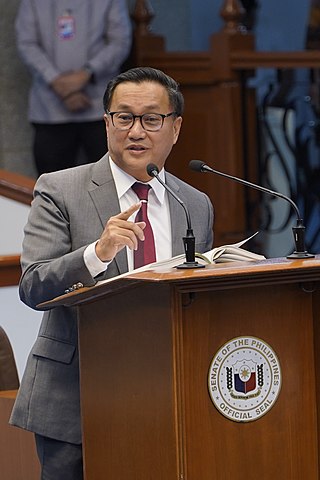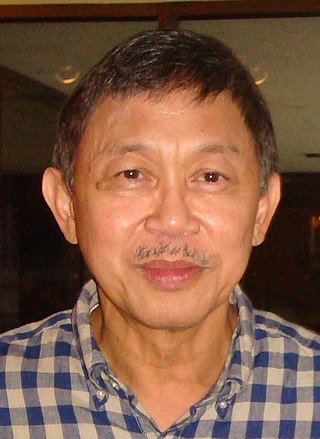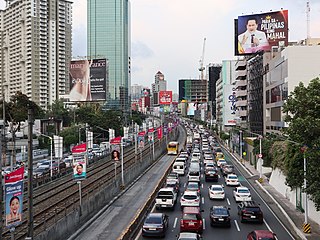
The Philippines, officially the Republic of the Philippines, is an archipelagic country in Southeast Asia. In the western Pacific Ocean, it consists of 7,641 islands, with a total area of roughly 300,000 square kilometers, which are broadly categorized in three main geographical divisions from north to south: Luzon, Visayas, and Mindanao. The Philippines is bounded by the South China Sea to the west, the Philippine Sea to the east, and the Celebes Sea to the south. It shares maritime borders with Taiwan to the north, Japan to the northeast, Palau to the east and southeast, Indonesia to the south, Malaysia to the southwest, Vietnam to the west, and China to the northwest. It is the world's twelfth-most-populous country, with diverse ethnicities and cultures. Manila is the country's capital, and its most populated city is Quezon City. Both are within Metro Manila.

Transportation in the Philippines covers the transportation methods within the archipelagic nation of over 7,600 islands. From a previously underdeveloped state of transportation, the government of the Philippines has been improving transportation through various direct infrastructure projects, and these include an increase in air, sea, road, and rail transportation and transport hubs.

The Pasig River is a water body in the Philippines that connects Laguna de Bay to Manila Bay. Stretching for 25.2 kilometers (15.7 mi), it bisects the Philippine capital of Manila and its surrounding urban area into northern and southern halves. Its major tributaries are the Marikina River and San Juan River. The total drainage basin of the Pasig River, including the basin of Laguna de Bay, covers 4,678 square kilometers (1,806 sq mi).

Ateneo de Manila University, commonly referred to as Ateneo de Manila or Ateneo, is a private, Catholic, teaching and research university, and a basic education institution located in Quezon City, Philippines. Established in 1859 by the Jesuits, it is among the oldest Jesuit-administered institutions of higher education in the Asia-Pacific.

The Metropolitan Manila Development Authority is a government agency of the Philippines responsible for constituting the regional government of Metro Manila, comprising the capital city of Manila, the cities of Quezon City, Caloocan, Pasay, Mandaluyong, Makati, Pasig, Marikina, Muntinlupa, Las Piñas, Parañaque, Valenzuela, Malabon, Taguig, Navotas and San Juan, and the municipality of Pateros.

The Department of Transportation is the executive department of the Philippine government responsible for the maintenance and expansion of viable, efficient, and dependable transportation systems as effective instruments for national recovery and economic progress. It is responsible for the country's land, air, and sea communications infrastructure.
Antonio Gabriel "Tony" Maestrado La Viña is at present Associate Director for climate policy and international relations and concurrently Head, Klima Center of Manila Observatory and a professor of law, philosophy, politics and governance in several universities in the Philippines. He is also a member of the Permanent Court of Arbitration in The Hague, the Chair of the Jurisprudence and Legal Philosophy Department of the Philippine Judicial Academy. the founding President of the Movement Against Disinformation, and the founding Chair of the Mindanao Climate Justice Resource Facility. He is also Managing Partner of La Viña Zarate, a human rights, climate justice, and general litigation law firm.
León María Ignacio Agapito Guerrero y Francisco,, better known simply as Leon Ma. Guerrero III, was a Filipino diplomat and novelist, and was one of the foremost Filipino nationalists of his era. A partner in the law practice of senator Claro M. Recto, he became Undersecretary of Foreign Affairs during the Magsaysay administration. His then controversial advocacy of Asia for the Asians and espousal of a realistic re-examination of relations with the United States are now commonly accepted as being ahead of their time.
Rodolfo Certeza Severino Jr. was a Filipino diplomat who served as the tenth secretary-general of ASEAN between 1998 and 2002.

The transportation system in Metro Manila covers the road network, rail network, ferries, ports and airports located within the metropolitan Manila area. Road transportation in Metro Manila is diverse, composed of many types of private and public transport vehicles. These include taxis, buses, jeepneys, tricycles and pedicabs. In some areas, especially in Divisoria and large public markets, two-stroke motors are fitted in the pedicabs and are used for goods transport. Regardless of modernity, horse-drawn kalesas are still used in the streets of Binondo and Intramuros. Ridesharing services such as Grab also operate within Metro Manila.

Francis Ng Tolentino is a Filipino politician and lawyer. He has served as a Senator since 2019.

Romulo Neri is a Filipino educator and public servant. He held several high-ranking government positions such as Secretary of Socio-Economic Planning and concurrently Director-General of the National Economic and Development Authority (NEDA), acting Secretary of Department of Budget and Management (DBM), Chairperson of the Commission on Higher Education and President of Social Security System under former President Gloria Arroyo. He is also involved in the controversial NBN–ZTE scandal involving corruption in the Philippine National Broadband Network project.

In 2023, official government statistics reported that the Philippines had a poverty rate of 15.5%,, significantly lower than the 49.2 percent recorded in 1985 through years of government poverty reduction efforts. From 2018 to 2021, an estimated 2.3 million Filipinos fell into poverty amid the economic recession caused by the COVID-19 pandemic.
The Pasig River Expressway (PAREX) is a proposed elevated expressway in Metro Manila, Philippines skirting the banks of the Pasig River and connecting the cities of Manila, Mandaluyong, Makati, Pasig, Taguig and the municipality of Taytay. The expressway is proposed to alleviate east-west traffic congestion in Metro Manila. It is envisioned as a joint venture between the Philippine National Construction Corporation and the San Miguel Corporation. The project broke ground on September 24, 2021, while construction of the expressway was yet to start, pending the approval of its Environmental Compliance Certificate (ECC). The project was deemed cancelled in 2024 due to public uproar against the project. However, Ramon Ang announced renewed interest in the project, albeit citing the need to adjust it toward public sentiment.

Shaw Boulevard is a 4-8 lane highway connecting the cities of Mandaluyong and Pasig in the Philippines. The boulevard is named after William James Shaw, founder of the Wack Wack Golf and Country Club in Mandaluyong. The road is one of the major thoroughfares of the Ortigas Center in Mandaluyong and Pasig, housing many shopping malls like the Starmall shopping center and the posh Shangri-La Plaza at the EDSA-Shaw intersection and The Marketplace, which is visible from the Kalentong-Shaw intersection and Sevilla Bridge.
The Metro Manila Dream Plan, formally titled the Roadmap for Transport Infrastructure Development for Metro Manila and Its Surrounding Areas, refers to a 2014 integrated plan for improving the transport system in Metro Manila, Philippines, with the hope of turning it into a focal point for addressing Metro Manila's interlinked problems in the areas of transportation, land use, and environment.

The Metro Manila Subway, formerly known as the Mega Manila Subway (MMS) is an under-construction underground rapid transit line in Metro Manila, Philippines. The 33-kilometer (21 mi) line, which will run north–south between Valenzuela, Quezon City, Pasig, Taguig, Parañaque and Pasay, consists of 17 stations between the East Valenzuela and Bicutan stations. It will become the country's second direct airport rail link after the North–South Commuter Railway, with a branch line to Ninoy Aquino International Airport.

According to a "Global Driver Satisfaction" survey conducted by the navigation app Waze in 2015, Metro Manila had the "worst traffic on Southeast Asia". Emerson Carlos, MMDA assistant general manager for operation has mentioned that in 2015, motor vehicle registrations in Metro Manila peaked at around 2.5 million.

The Public Transport Modernization Program (PTMP), formerly and still commonly referred to as the Public Utility Vehicle Modernization Program (PUVMP), is a program made by the Department of Transportation (DOTr) of the Philippines in 2017, with the goal of making the country's public transportation system efficient and environmentally friendly by 2020. The program calls for the phasing-out of jeepneys, buses, and other public utility vehicles (PUVs) that are at least 15 years old and replacing them with safer, more comfortable and more environmentally-friendly alternatives over the next three years. As of project inception, there were around 220,000 jeepney units operating throughout the country. The program also calls to all PUV Drivers and Operators to join or form a Transport Cooperative.

Cycling is a popular mode of transport and recreational sport in the Philippines. Bicycles were first introduced to the archipelago in the 1880s during the Spanish colonial occupation of the Philippines and served as a common mode of transport, especially among the local mestizo population.














